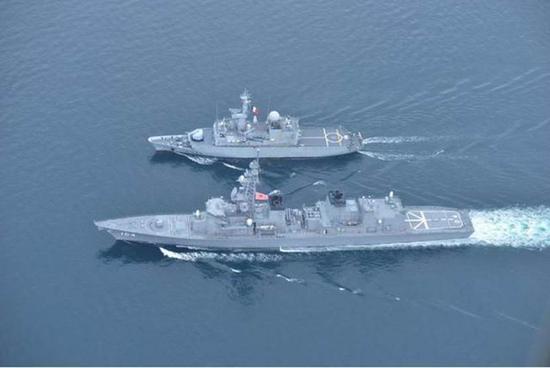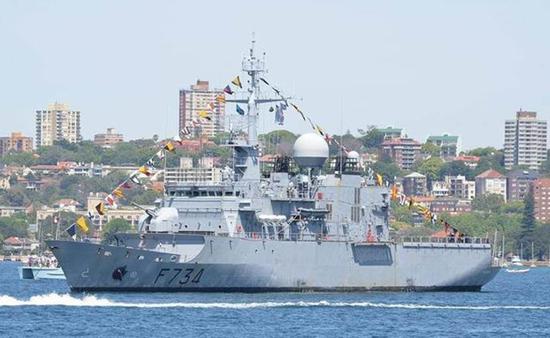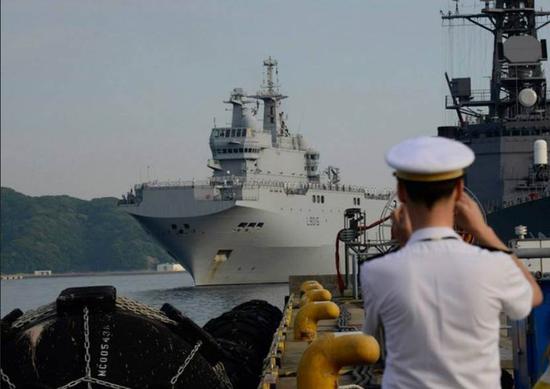According to Japan’s Sankei Shimbun, France plans to participate in the first joint amphibious landing training on outlying islands in May next year. At that time, French, Japanese and American ships and land forces will launch landing training on uninhabited islands southwest of Japan.
With the recent changes in the security situation in the Asia-Pacific region, European countries are paying increasing attention to the region. As an established European power, France, although its strength is not as strong as before World War II, it still shows its willingness to show its military strength in the Asia-Pacific region.
In recent years, France has sent many battleships, including the “Northwest Wind”-class amphibious attack ships and the “Lafitel”-class frigates, to the Asia-Pacific region to show its overseas deployment and combat strength, actively carry out defense cooperation with Asia-Pacific countries, and continuously increase its intervention in Asia-Pacific affairs.
France’s participation in the Japan-US joint training is the first time in history. It shows its strong will to further strengthen its strategic relationship and practical existence with countries in the Asia-Pacific region. At the same time, it is also an important measure for its expanding its influence and voice in Asia-Pacific affairs.
France-Japan defense cooperation gradually heats up
Although France’s defense cooperation with Japan started late, the process has been accelerating and expanding rapidly in recent years. In March 2015, the governments of Japan and France held a “2+2” consultation between the foreign ministers and the defense minister, during which the Agreement on Defense Equipment was signed.
Prior to this, Japan had signed relevant agreements with Britain, the United States and Australia, and France became the fourth country to sign the agreement with Japan.
According to the agreement, Japan agreed to jointly develop unmanned diving aircraft using advanced Japanese technology for alert surveillance with France, and will launch the “Defense Equipment Cooperation” and “Export Management System” committees of the two countries to strictly manage the products jointly developed by the two countries, which is important for Japan to expand national security cooperation outside the United States.
One of the measures marks the further deepening of cooperation between the two countries in the field of security.
In January 2017, Japan and France reached an agreement to start negotiations on the mutual provision of materials and services between the armed forces of the two countries, and the agreement was officially signed in July 2018.
According to the agreement, the two sides will provide each other fuel, ammunition and other materials, and expand cooperation in transportation and maintenance. In addition, the two countries are also actively seeking to join the “Five Eyes Alliance” and build a “5+2” intelligence sharing mechanism within the framework of this alliance, which further warms up Japan-French defense cooperation.
In terms of joint training, France and Japan have strengthened bilateral or multilateral cooperation since 2015. In May 2017, the French Navy’s “Nestral Wind”-class amphibious attack ship held its first joint exercise with Japan, the United States and Britain while docking at the Sasebo base of the Japanese Maritime Self-Defense Force.
In May 2019, France sent the “De Gaulle” aircraft carrier and the US-Japan-Australian ships to hold a large-scale joint military exercise in the Indian Ocean, gathering large formations on the sea to show their force.
According to reports, France plans to send helicopter amphibious ships and frigate fleets with naval midships to participate in joint training in May next year, and the army troops stationed in French Polynesia will also participate in the training, nominally for humanitarian assistance and disaster relief, but in fact it will be performed.
The training courses, including landing training for take-off and landing aircraft on uninhabited islands and landing training courses for amphibious vehicles and ships, are mostly the same as those for outlying islands defense and recovery operations, and the targeted courses are self-evident. In an interview, the French naval chief of staff van Dieer said, “The message [military exercise] is sent to some rising powers.
We want to show our influence in the region and send a signal of Japanese-French cooperation”, which also shows the intention of the two countries to create a new arc around Asia and achieve high-pressure. The effect of the situation holding the opponent.

France turns around Asia and strengthens its efforts
As a traditional continental power and permanent member of the United Nations, France has great influence in the world, with an army of advanced weapons and equipment, strong overseas intervention ability and strong will. However, with the decline of Europe’s overall influence in recent years, France’s international voice has gradually weakened, and the sense of regional presence has been weakening. There is a tendency to become a regional second-rate power. Especially in terms of military power, the French navy’s influence over ocean-going areas has been declining day by day. To this end, France began to look at the Asia-Pacific region, hoping to demonstrate its power deterrence and enhance its international status and influence through interference in the region.
In fact, as early as August 2013, when French Foreign Minister Fabius said in his speech to the ASEAN secretariat that “France will also turn to Asia” and put the Asia-Pacific region into France’s international affairs. In Asia-Pacific affairs, France has obviously paid more attention to the South China Sea issue and taken many actions. In June 2016, French Defense Minister Lud Leon publicly stated at the Shangri-La Dialogue in Singapore that he would promote the participation of EU navies in the South China Sea cruise to ensure a “regular and visible presence” of Europe in the region. In January 2017, France criticized China’s construction of islands and reefs in the South China Sea at the “2+2+2” talks between Japan and France, and sent warships to frequently appear in the South China Sea, or join the United States’ “freedom of navigation” operation, or participate in multilateral joint military exercises in the region. The purpose is to take the South China Sea as the starting point and increase Asia-Pacific affairs. The strength of intervention.
At the same time, France has also vigorously strengthened its relations with regional organizations. It has frequently spoken out in important Asia-Pacific strategic forums such as the Singapore Shangri-La Dialogue, the ASEAN Regional Forum, the Pacific Coast Guard Forum, etc., and has continuously established extensive cooperation with Southeast Asian and South Asian countries to establish and improve nuclear proliferation prevention and restrictions. Cooperation mechanisms in the fields of the South China Sea Territory, anti-terrorism, climate change and so on. In terms of defense and security, it advocates the establishment of “regional strategic thermometers” and the Asian Defense Ministerial Conference, and hopes to cooperate with them. Essentially, France hopes to restore itself to a “global power” by pursuing multilateralism and maintaining a regional balance of power.

Indo-Pacific Strategic Alliance is difficult to form.
It is puzzling that although France is located in Europe, it has always defined itself as an “Indo-Pacific” country, and the concept of “Indo-Pacific region” is defined as an area from the coast of East Africa to the west coast of the United States.
France believes that because it owns French Polynesia, New Caledonia, Wallis and Futuna in the South Pacific, and Réunion, Mayotte and Kergren in the Indian Ocean, if it is added to the overseas territories of the Caribbean, its exclusive economic zone is about 11 million square kilometers, of which 62% The economic zone is located in the Pacific Ocean, with about 1.5 million French citizens living in the Indo-Pacific Territory.
Moreover, in terms of military force deployment, France has 2,800 troops in the region and nearly 10 battleships deployed, of which two capital ships, the frigate “Foggy Moon” and the frigate “Portuguese Moon” are deployed. At the naval base of Tahiti in French Polynesia, there is therefore a wide range of interests in the region.
Under the influence of this concept, in recent years, France has followed the cooperation mechanism of the four countries of “US, Japan, Australia and India” and continuously strengthened defense cooperation and interaction with Japan, Australia and India, trying to form a similar Indo-Pacific “strategic alliance”. In March 2018, French President Macron visited India for the first time since taking office.
The two countries signed a series of strategic cooperation agreements, including the sale of 36 “gust” fighters to India, allowing “the armed forces of the two countries to provide logistical support to each other”; in May 2018, during his visit to Australia, Macron’s first Propose to build a “strategic alliance” between France, Australia and India, and signed a “strategic partner” contract with Australia in February 2019 to purchase 12 new generation conventional power submarines with a total value of A$50 billion, which is the largest arms purchase plan in Australian history and the French naval collection.
The largest overseas sales contract of the group. And with the recent approach of Franco-Japanese relations, the “strategic alliance” between France, Japan, Australia and India seems to begin to take shape.
However, “idea is full, and reality is bone-feeling”. Because France is located in Europe after all, it is constrained by military spending cuts and Europe’s own defense, it is impossible to invest its main energy and military resources in the “Indo-Pacific” region. France’s increased participation in the “Indo-Pacific” region is partly due to its attempt to promote its international position through military operations in the region to promote its influence in Europe.
Moreover, France and China do not have a fundamental conflict of interest. Deepening defense cooperation with Japan, Australia and other countries does not mean that it must “select the sidelines” on the South China Sea issue. The will emphasized such as “freedom of navigation”, “compliance with international law” and “peaceful settlement” is not clearly directive, and it is not clear with the countries around the South China Sea. The defense cooperation of the defense is very limited in depth and breadth.
In addition, France also recognizes that for Japan, India, Australia and other countries, the long-term intention of defense cooperation with France is to borrow France’s “leading” position in the EU and approach the EU through its proximity to the EU in the defense system, so as to achieve political and military cooperation with the EU in the foreseeable future.
Then, in turn, the EU was introduced into the “Indo-Pacific” to curb the rise of the opponent’s influence in the region. In view of the contradictions between these countries and their opponents on many issues in recent years, most of them use disrupting and destroying to create chaos, hoping to realize their own sinister intentions for self-interest. Therefore, while cooperating with these countries, France will also remain highly vigilant and try to avoid becoming the self-interest of these countries inadvertently.
Footstone. Therefore, in this case, the construction of the so-called “Indo-Pacific Strategic Alliance” is only a symbolic idea, lacking a solid basis for common interest.



